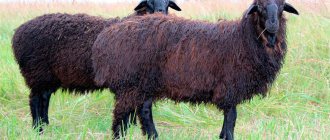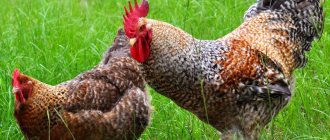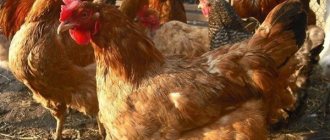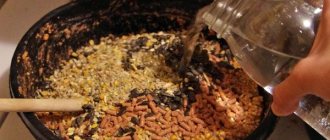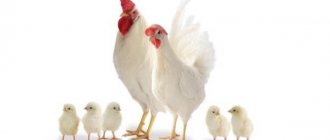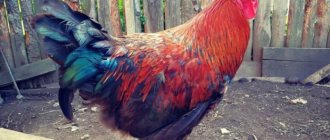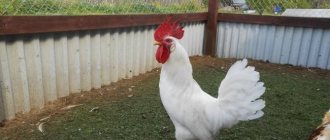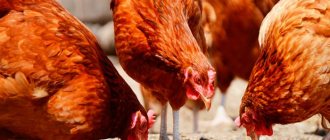Description and breed standards
Chickens of the Amrox breed belong to the meat and egg breed and are of a medium-heavy type. The weight of a chicken can reach up to 3 kg, and a rooster up to 4 kg of live weight. Amroks are good layers, and so are their mothers. Birds have a lively temperament, but on the other hand they can easily get along with other birds.
Cock standards
The rooster's head is medium in size and its comb is large. The beak is short and yellow, the tip is slightly curved. The comb is red, stands straight, its shape is simple, there are from 5 to 6 teeth. If you look at the bird from the side, it should form an even arc.
The earlobes with earrings are red in color, the length of the earrings is medium, oval in shape. The lobes are oblong with a smooth base. The eyes are large and dark red.
Neck length is medium, fully feathered. The body is slightly raised, wide with an oblong shape. The chest is muscular and deep. The loin and back are wide. The body, neck and tail smoothly bend upward. The back is flat along the entire line, and near the lower back the line turns into a tail, which is set vertically. The belly is full and wide.
The wings are pressed tightly to the body, their length is medium, and widely feathered. The legs are medium, on top of which there is a thick feather. The metatarsals are yellow or pink with a stripe. Fingers are rich yellow, nails are light. The tail is set at an angle of 45 degrees, wide, of medium length.
Chicken standards
Chickens of the Amrox breed differ from roosters in the following characteristics:
- wider and deeper body;
- the neck is thinner;
- the feathers on the tail barely protrude from the feathered body;
- yellow beak with black stripes;
- metatarsus yellow.
Amrox chickens are exclusively cuckoo in color; the feathers can have either white or black stripes. The down cushions of the feathers are striped, and the tips of the feathers are black. A rooster's stripes are the same width, but a hen's black stripe is much wider.
Breeding Amrox chickens
Amrox chickens are excellent brood hens and hens. It is important to create spacious and comfortable nests. Since these birds hardly fly, it is worth building small ladders or stands with which the hens can easily climb into the nest boxes. Their bottom is lined with soft straw for comfort and heat retention.
The incubation period for eggs lasts 21–23 days. At this time, the hen leaves the nest only to feed. It is important to ensure that the bird approaches the feeder. After the chicks are born, the hen willingly takes care of them.
Recommendations for purchasing chickens for further breeding
It is not easy for new farmers to select suitable birds for breeding. What to look for when purchasing:
- General state. A healthy bird is active and mobile, standing well on its feet. Lethargy, drowsiness, lack of reactions to stimuli are signs not of fatigue, but of illness.
- Condition of the feather cover. The bird must be clean, the structure of the feathers must be uniform, without bald spots. Inspect the cloaca - if there are remains of droppings on it, the bird may be suffering from an intestinal disorder.
- Leather. When buying chickens, you need to assess the condition of the skin by parting the feathers. Wounds, redness, bite marks are signs of infection with ectoparasites, as is the presence of the insects themselves.
- Eyes and beak. They should be clean and look alive. Discharge from the nasal passages and breathing through an open beak are bad signs; it is better to avoid buying birds.
- Paws. The skin on the limbs of healthy birds has a uniform color. Rough, raised scales indicate infection with knemidocoptic mange, a parasitic disease of chickens. Fingers should be straight.
- Inspection of the umbilical cord in chicks is mandatory. Redness and purulent discharge are signs of inflammation. Such young animals are not worth buying.
These guidelines will help the farmer buy healthy chickens, but meeting breed standards is also important. Before purchasing young animals, you should ask the seller to show documents confirming that the birds have been vaccinated.
Origin story
The breed itself comes from Germany, which was bred in the mid-20th century, and was included in the standard only in the 50s. You don’t often see Amroks at poultry farms; they breed fast-growing chickens (which can’t be said about this breed), but the birds are well suited as genetic material for crossing and creating new breeds.
Soon, a new type of chicken became popular in Western Europe. At first, this breed was liked by small farmers and people who kept private farms for themselves. But industrial factories were not interested in them.
Character
Roosters and hens have an active, inquisitive nature. The breed is peaceful, birds rarely conflict. Adding new animals to the livestock is easy. Chickens are good mothers and take careful care of their offspring. Amroks love to sit on a perch and sleep there at night. The poultry house should be equipped with vertical perches for resting birds.
Be sure to read:
Champions in productivity and a popular breed in Russia - Leghorn chickens
Productivity Amrox
Birds of the Amrox breed have a high survival rate:
- young animals 95%;
- mature age 92%.
They grow quickly; by the age of six months, hens reach 2.5 kg, and roosters 4 kg. After which the growth rate slows down, but growth continues for up to one and a half years. Puberty begins at 6 months, from which point egg laying begins.
Laying hens are capable of laying their first eggs at six months of age. At first the egg production is 220 eggs, then the figure drops slightly to 180 eggs. The shell is cream or light brown in color.
Amroks have a dwarf type. Adult males reach 1.3 kg, and chickens 1.2 kg. The annual egg production is 140 eggs.
Maturation and egg production
And again about the advantages - birds are famous for their high speed of puberty and growth. Already at 5-5.5 months they begin their “chicken work” - laying eggs. This process is established in pullets quite quickly, and already in the first year they achieve maximum productivity.
In subsequent years, their “labor” activity declines. On average, the black whale produces 200 eggs per year, each weighing about 60 grams. Absolutely all eggs in shells are brown, mostly in light colors.
Advantages and disadvantages
The advantages of the Amrox breed include the following:
- high productivity;
- rapid adaptation to weather conditions and new habitats;
- high percentage of survival and hatching rate (about 100%);
- high meat taste indicators;
- Even roosters have a calm disposition.
As for the disadvantages, they are as follows:
- there is no proportionality in the broods; more cockerels are born than hens;
- there is a risk of early puberty; if early egg laying begins, the eggs will be small and not of such quality.
Reviews
According to poultry farmers, the advantages of the breed include:
- intensive growth. Allows you to quickly send birds for sale, reduce costs for fattening each individual;
- easy adaptation to conditions. Chickens can be sold even as adults; they will not suffer when moving, and they will not get sick when the climate changes;
- good-natured disposition. The breed can be housed with other species in a common area. This way the farm becomes more compact, but more profitable;
- good maternal instinct. There is no need to spend money on an incubator;
- popularity. Young animals and eggs are always in demand for sale.
The main disadvantage of the cross lies in the disproportion of sex in the broods.
There are always more cockerels hatched than hens. The small number of females creates certain difficulties in forming families for population growth.
Experienced breeders suggest solving the problem by keeping adult roosters. It has been observed that older ones produce greater gender diversity in their offspring than younger ones.
The second disadvantage is the risk of early puberty in laying hens.
If they begin to lay eggs before 6 months, then the product is of low quality and small.
In addition, the body quickly becomes exhausted, and inflammation of the oviduct appears. The deficiency can be corrected by controlling daylight hours in young animals. From 4 to 6 months, lighting does not exceed 12 hours.
To maintain their instincts, the chicks are kept separately from the chickens so that the squeaking is not heard.
Breeders' comments
Specialists on the Amrox breed note some regular features:
- Good laying hens' paws become lighter with age. The pigment goes into the formation of the eggshell. The bright yellow legs of an adult hen are considered a reason to cull a female;
- Some Amroks prefer to trot on the floor. It is worth observing the behavior of chickens during puberty - females will look for a place and drag straw to their favorite place;
- the quantitative release of eggs decreases in frosts around -25°C and in heat above +30°C;
- The productivity of laying hens decreases after 2 years. Keeping them longer is not beneficial;
- in the warm season, the size of the eggs becomes smaller, but their number increases. Corrected by adding additional protein to the laying hen’s diet;
- eggs may have too thin a shell or no shell. Corrected by adding phosphorus and calcium to food. Meat and bone meal is suitable for these purposes;
- For successful breeding, each rooster should have no more than 10-12 hens.
Exterior defects
Exterior defects of Amroks include:
- beautiful bones;
- narrow or short body;
- narrow back;
- the chicken has an empty belly;
- elongated and thin beak;
- small deep eyes;
- eye color other than dark red;
- short or vice versa long legs;
- elongated toenails;
- rough scales;
- there is no black color on the tail feathers;
- there are no stripes on the down;
- very thin stripes on feathers;
- the presence of a different color on the feathers;
- low egg production;
- poor survival rate.
Rejected birds are not allowed to breed this breed of chickens - we are talking about factory birds. If the rejects end up in a household, they are not thrown away because the quality of their eggs and meat does not change.
Diseases and their treatment
The Amrox breed of chickens is resistant to infectious diseases, but despite this, it requires vaccination and protection against worms and parasitic insects.
The risk of infection by bacteria and viruses increases when chickens are kept in a damp, dirty, poorly ventilated area. Chickens should also not be allowed to dig into compost and manure heaps. Where they can become infected with helminths.
To protect against feather and skin parasites inside the chicken coop and in the aviary, it is recommended to install a container filled with a mixture of sand and ash.
The chicken coop must be regularly treated for rodents, as they are carriers of many infectious diseases.
An important factor in maintaining the health of chickens of this breed is a sufficient amount of ultraviolet radiation accumulated in the body over the summer.
Birds need to spend as much time outside as possible from early spring to late autumn.
If hygiene requirements are not met in the chicken coop, Amroks become infected with knemidocoptic mange - the scabies mite.
The birds' legs are covered with white scales, which gradually turn into bumps on the unfeathered part of the legs. In its advanced state, the disease leads to immobility and death of the bird.
If hygiene requirements are not met in the chicken coop, Amroks become infected with knemidocoptic mange.
Maintenance and care
There are two options for keeping birds - walking and non-walking. In the first option, the chickens are outside all the time, and in the second option they sit indoors. Of course, the walking method is better, since weight gain occurs faster. The same applies to the quality of meat and eggs; free-range products contain more vitamins and other substances.
This breed of chickens is not capricious and is not picky about living conditions. It is only important to know about the rules of care:
- In the chicken coop where chickens and grown-up chickens live, there must be good ventilation to avoid the formation of mold. A dry room is also important, and increased moisture can be detrimental to the health of the birds.
- The room must be filled with ash and sand in sufficient quantities, both in summer and winter. Chickens bathing in this mixture do an excellent job of fighting parasites that settle in their down.
- Chickens of the Amrox breed need space, although they are friendly birds, but still a small room is not suitable for keeping them.
- Birds do not tolerate cold well, so it is important that the chicken coop be warm at any time of the year.
- The room must be regularly cleaned, bedding changed and ventilated.
- The chicken coop must be disinfected by whitewashing the surfaces with peat and lime.
- Lighting should be controlled - turn on artificial light in the evening, and stay without windows during the day.
- An hour after eating, the feeders should be washed, and the drinking bowls should be washed once a day.
- Before winter, the thickness of the litter needs to be increased.
Arrangement of the premises
The poultry house can be placed either separately or occupy some part of the farm premises. In the chicken coop, it is advisable for Amrox chickens to have windows on the south side, this will save on lighting. There should be no cracks or leaks in the room. For ventilation, it is recommended to remove the air duct.
During construction, the floors are raised by 35 cm, this will protect the birds from rodents and small predators. In addition, you can put a thick board from 20 mm.
Flooring can be made from:
- straw;
- peat;
- stones
Next, corners are allocated where feeders, drinking bowls and other equipment will be placed. Sticks are installed on top on which the birds will sit and a ladder leading to the perch.
Since chickens do not like noise, you need to build the room in a quiet place, or make sound insulation. Especially when chickens are sitting on eggs, at this moment they are very susceptible to various sounds. Stress can cause poor productivity.
The room temperature should not exceed 20 and not be lower than 16 degrees. The dimensions of the room are calculated based on the number of livestock. For 1 individual you need 1 square meter. Not far from the poultry house, you need to build a 2x10 m walking area for 10 chickens. This area needs to be fenced off with a 1.5 meter high mesh. This area should have an abundance of grass and a canopy from the sun and rain.
How to make a chicken coop with your own hands is written in this article.
Feeding
Such chickens do not need special nutrition, which is good for breeding in large quantities. For babies, crushed grains and boiled crushed eggs are suitable. It is allowed to give millet instead of grain. When the chickens get a little older, chopped vegetables are added to their diet. After a couple of months, you can feed crushed corn, which is important for rapid growth. They should be fed in portions, but often, otherwise obesity may appear, which they do not need.
To quickly gain weight, chickens are allowed to be fed with mixed feed and other additives for growth. An important condition is to add vitamins to the diet in the required quantities. If the birds are free-range, they will get everything they need for themselves. An adult chicken eats approximately 150 g of feed per day.
The table shows food varieties and types of feeding.
| Feed | Products | Type of feeding |
| Corn | Millet (wheat), barley, oats, sometimes buckwheat | Wet mash based on water or whey. In winter, on fish broth |
| Legumes and vegetables | Potatoes with skin, carrots, beets, corn and peas. Occasionally cabbage | Served boiled, crushed, along with mash |
| Greenery | Clover, dill, tops, nettle, dandelion | Give crushed along with grain or add to porridge |
| Protein | Fish dust, egg white, cottage cheese | Boiled, crushed with porridge |
| Supplements | Chalk, eggshells, bone meal, yeast, fish oil, salt, pebbles, gravel | In a separate bowl or together with mash |
During the laying period, hens are given grain and calcium, and roosters are given protein. Read more about proper feeding of laying hens here.
Breeding
Chickens of the Amrox breed reproduce well; there is no need to buy chickens once a year, because the chickens themselves are able to hatch eggs with a high survival rate. If you don't want to place a chicken on eggs and wait for the chicks to hatch, the eggs can be placed in an incubator. In this case, the survival rate is 80%. You can read more information about the rules for incubating chicken eggs here.
While incubating eggs, chickens are provided with a nest made from a basket, wooden crates or simple boxes. A thick layer of straw is placed on the bottom, but it must be soft. There should be a ladder leading to the nest so that the quonka can easily reach the nest, because they cannot fly.
A chicken hatches eggs for 21 to 24 days; it is important that during this period she comes out to eat. If she herself does not want to do this, then she needs help - move her to food, then return her back. In the first days after birth, the chicks only need to be fed, and the new mother will do the rest.
Chickens
The chickens have thick plumage that fits tightly to the body, are dark red in color, and have small white spots on the belly. Chicks hatch from hatching eggs on time weighing 40 grams. At first, weak babies need to acclimatize and get used to new living conditions. This may take from 10 to 12 hours. Then they should be fed, watered and moved to their own housing.
The advantage of this breed is that it is possible already in the first day to distinguish which are the hens and which are the cockerels, and from the first days they can be separated by sex.
For the first 3 days, chickens should have constant light, then gradually reduce it to 2 days, and then to 5 hours a day. An important condition is the timely replacement of bedding and dryness in the room.
Diseases and prevention
This breed of chickens practically does not get sick, but prevention still won’t hurt. If infectious diseases pass by, parasites can infect. Down feather eaters, fleas, and mites worsen the condition of feathers, which can subsequently lead to the appearance of bacterial and infectious diseases. Also, damaged plumage can lead to hypothermia or, conversely, overheating of the bird.
To avoid this, you should make ash baths and place them in the corner of the room, where wood ash and sand are added in a ratio of 0.5:05. If a bird has a tick, it is recommended to add colloidal sulfur to the bath.
For preventive measures against infectious diseases, antibacterial agents should be used, which can be purchased at a veterinary pharmacy. It is also very important to get all necessary vaccinations on time.
Keeping birds on a private farm
Amrox chickens are best kept on the floor rather than in cages. A low level of physical activity negatively affects metabolism and egg production. Representatives of this breed do not require much attention, but they still have some characteristics. The farmer must take them into account when arranging the poultry house.
Proper care of chickens
The presence of a walking yard is desirable for this breed of chickens. Daily walks strengthen the immune system and help prevent rickets. When setting up a walk, the fence is kept low - up to 1.5 m, since Amroks almost do not fly. The canopy will protect the birds from rain and scorching sun.
Chicken coop requirements:
- There are 5 chickens per 1 m2 of area.
- Presence of nests and perches. The latter are installed at a distance of 40 cm from the floor.
- The temperature in winter should not fall below +14 degrees.
- The permissible level of humidity in the room is 60%.
- Availability of dry and clean litter.
- Sufficient number of drinkers and feeders.
- Good ventilation.
It is important to keep the poultry house clean by regularly changing the litter. Disinfection of floors and walls with lime and special solutions is carried out 2-3 times a year. This will help protect birds from infectious diseases and parasites. Chickens love to bathe in dust, so a container filled with a mixture of sand and wood ash is installed in the poultry house.
Bird diet
To achieve a high level of productivity, it is recommended to feed Amrox chickens with ready-made mixed feed, which includes all the necessary nutrients and vitamins. If this is not possible, you need to try to make their diet varied. It includes:
- Grain - wheat, oats, barley. Grain feed is not only given in dry form, wet mash is prepared from it, sprouted and steamed.
- Beans - corn, lentils and peas.
- Vegetables – carrots, potatoes, beets (fodder), pumpkin.
- Herbs - nettles, dandelion greens, dill, onions, tops of garden crops.
- Boiled boneless fish, low-fat cottage cheese, yogurt.
Attention! Sources of minerals include: chalk, shell rock, salt, crushed egg shells, fish oil.
Feed is distributed at the same time three times a day. During the daytime, they offer greens and vegetables, and grains in the morning and evening. During intensive egg laying, the diet of laying hens is enriched with protein and calcium.
Prospects for breeding in Russia
This breed of chicken, like no other, is suitable for keeping in private households and small factories, since they are easy to maintain and feed. Amroks are especially suitable for beginner poultry farms.
This breed could also be used in large enterprises, since productivity is quite high. But still, poultry farms give preference to highly productive layers and early maturing broilers.
Molting and pause in egg laying
If in the middle of autumn you stopped taking eggs from the nests due to their absence, this does not mean that there is something wrong with your laying hens. This only indicates that they have begun seasonal molting, which always entails a break in egg laying. No treatment is needed - shorten the daylight hours, and also feed the mangy chickens well.
As practice shows, American laying hens are most productive only in the first year of laying. The rest of the time, they annually reduce productivity by 15-20% annually. Therefore, experienced poultry farmers send birds to slaughter after the end of peak productivity, replacing them with grown-up young animals.
Purchasing a breed
It is better to purchase both young animals and hatching eggs of Amrox chickens in special stores. They can be found on the Internet, purchased through pickup or delivery.
The most popular sellers are:
- LPH "Ryaba Chicken". Location: Moscow and Moscow region.
- Ecofarmer-Shop. Location: St. Petersburg and Leningrad region.
- Zoomir. Location: Moscow and region.
You can also purchase good birds at exhibitions. You should not take risks by purchasing chickens from your own hands, since there is a possibility of defects or sick individuals.
Hatching eggs can be bought from 60 to 100 rubles apiece. A chicken that is one day old costs from 150 to 190 rubles. Young animals are not budget-friendly, since for one individual you need to pay from 1,500 to 2,000 rubles.
Amrox chickens are suitable for those who need high-quality eggs and meat. Both beginners and experienced professionals can handle these birds. They can become both family helpers and generate considerable income when selling products.
Frequent illnesses
Amroks are susceptible to typical chicken diseases:
- Eimeriosis (coccidiosis). Caused by parasites. Chickens 2-8 weeks old are susceptible to the disease. Mortality reaches 100%. Treatment: coccidiostatic drugs.
- Newcastle disease (pseudoplague). A viral disease affects the entire livestock within 2-3 days. Symptoms: incoordination, paralysis, diarrhea, loss of appetite. Mortality 90%. No treatment has been developed.
- Plague of chickens Viral disease. Symptoms: lethargy, blue earrings and comb, discharge from the beak. Mortality: up to 100%. Treatment: not developed.
- Marek's disease (bird paralysis). Viral disease. Symptoms: lethargy, unnatural postures, exhaustion, decreased productivity. Mortality: 46%. No treatment has been developed.
- Leukosis of chickens. A viral disease that affects birds older than 4 months. Symptoms are subtle: exhaustion, decreased productivity, blue scallop, diarrhea. There is no treatment.
- Laryngotracheitis. Viral disease. Symptoms: wheezing, cough, difficulty breathing. Mortality reaches 50%, the death of the bird occurs from suffocation.
Be sure to read:
Top 16 meatiest chicken breeds: description and photos of “heavyweight chickens”
Amrox
The breed is characterized by high immunity. With timely vaccination and treatment of livestock against parasites, the probability of disease occurrence is 1-5%.
Amrox reviews and notes from breeders
Breeders' notes:
- Laying hens' paws become lighter with age, and the pigment goes into the formation of eggshells. Bright paws are a reason to reject a chicken.
- Some specimens like to lay eggs directly on the floor. During puberty, you need to monitor their behavior, because at this time they will rake straw to a certain place.
- The number of eggs decreases during frosts and extreme heat.
- The productivity of birds decreases after 2 years from birth.
- In summer, the eggs become smaller, but their number increases. This can be corrected by adding protein to your diet.
- Eggs may have no shell or may have a thin shell. In this case, it is necessary to add phosphorus and calcium to the diet.
Below are reviews from real people about Amrox chickens.
★★★★★
Katerina Kots, Moscow region. We purchased chickens that had already been raised from private hands.
To be honest, they weren't the best of the best. And we bought them because these were the only ones and my husband was afraid that we simply wouldn’t find others. We took 8 hens and 2 roosters. Already at home they noticed that one of the roosters had crooked fingers and experienced people advised him to make soup from it, since the descendants would be born with the same anomaly. ★★★★★
Nadezhda Kvarts, village. Pervomaisky. Last year in May I got Amrox chickens.
In mid-autumn they already began to lay eggs. This breed is tame and gets underfoot all the time; one even likes to sit on its knees. Birds give birth three times a season, and their mothers are simply excellent. Hide
Add your review
Amrox chickens are profitable and pleasant to keep on a private farm or on small farms. It is important to be very careful when purchasing a breed, since they may sell a non-pure breed or a sick bird. Individuals are not whimsical in maintenance and care, as well as in feeding, so even beginners can have such chickens.
0
0
Copy link
Feeding adult chickens
Amroks are undemanding when it comes to nutrition, but the diet should be varied. Poultry meat raised with proper feeding has a soft, delicate taste. A sufficient amount of animal protein and mineral salts in the diet increases the productivity of laying hens.
Rooster amrox
The diet should include:
- Cereals.
- Bran.
- Roots.
- Green grass.
- Animal protein.
- Mineral fertilizing.
Recommended proportion of grains: 60% of the diet. It is useful to give root vegetables, corn, fresh green grass. For feeding, you can prepare mixtures yourself or buy combined feeds with the desired composition.
Be sure to read:
Adler Silver - description and characteristics, advantages of the breed
Description of appearance
The breed is represented by tall, large birds, the appearance of which has the following features:
- wide, oblong body;
- medium sized head;
- developed muscles;
- broad chest;
- strong legs;
- heavy bones;
- a short powerful neck with a fluffy collar;
- slightly protruding brown eyes with a red tint;
- loose, protruding feathers;
- bright red facial area, wattles and fleshy comb;
- wide and fluffy tail.
The motley outfit of the Amrox chickens requires a separate description. It has a cuckoo pattern, in which each feather is colored light gray and black . Roosters appear paler than females, since their stripes are the same width. In laying hens, the main color of the plumage is black, and the gray stripes seem to be drawn according to the main color.
Amrox chickens are born black, with white spots on their bellies. From the first days it is easy to distinguish females from roosters, since laying hens were marked by nature with a light spot on their heads.
Professional farms carefully monitor the purity of the breed , rejecting individuals that do not meet the standard. The following characteristics are considered marriage:
- flight feathers are black;
- discrepancy between the colors of the eyes, metatarsus and beak with the description of the standard;
- beak and claws too long;
- lack of dark edging on feathers;
- a small number of dark stripes;
- elegance of proportions;
- short or narrow body.
Chickens are also screened using approximately the same criteria. And the absence of black stripes on the feathers of chickens indicates that they may also lag behind in physical indicators.
Historical information about the appearance of the breed
Officially, the birthplace of breeding and registration of the variety is Germany. But some poultry owners claim in all seriousness that the chicken was brought from the United States after the Great Patriotic War ended. The majority is still inclined to the generally accepted version, according to which German breeders obtained a new breed by crossing striped Plymouth Rocks. But does it really matter where a bird comes from? The main thing is that its qualities completely satisfy the owners of poultry farms.
Breeding chickens
Amroksa laying hens are also excellent hens, so it is not at all difficult for the farmer to replenish the livestock on his own. The babies quickly fledge, and this excellent quality allows them to painlessly adapt to cold climatic conditions.
Chickens grow quite quickly. Although at first they are slightly inferior in growth to the Kuchinskys, by 4 months they catch up with them in numbers, and soon surpass them. For faster growth, it is recommended to add boiled fish to the feed, adding it to mash, or use complete feed.
The baby's diet consists of crushed grain and crushed boiled eggs. Later it is supplemented with vegetables (boiled): carrots, beets, potatoes. Then the menu includes yeast supplements, green herbs, and bran.
At the age of two months, chickens begin to be given corn grain and fish oil. The feed dose per meal must be strictly controlled. Amroks are prone to obesity, which will invariably affect their egg production and physical condition.
Advantages:
- Performance.
- Product quality (eggs and meat).
- Ability to adapt.
- Preserved brooding instinct.
- intensive growth of birds;
- calm and good-natured disposition
- great maternal instinct
Flaws:
- Short peak period.
- High cost of hatching eggs and chicks.
Peculiarities
- the breed does not tolerate dampness;
- natural ventilation must be provided in the chicken coop to avoid the appearance of mold and viruses that cause diseases;
- floors must be regularly disinfected, peat should be spread on the floor surface or sprinkled with lime;
- chickens should have access to dry ash mixed with sand, which will allow them, by bathing in such a mixture, to get rid of parasites in their plumage.
With proper maintenance, mortality of this breed is practically eliminated. They do not require much space to maintain them, so they are often bred not only in rural areas, but also in cities.
Productivity
Chickens of this breed are representatives of mixed productivity. They are characterized by good results in the production of meat and eggs. Amrox chickens have good survival rate at any age. The loss of young animals is approximately 5%, and of adults up to 3%.
Chickens grow up to one and a half years of life. Hens begin to lay eggs after about 5-6 months and egg laying continues throughout the year. In 1 year of life, an adult chicken can lay almost 220 large eggs. The mass of such an egg is 60 g with a strong and dense light brown shell. In the second year of life, the egg production of chickens decreases slightly, and they produce 200 eggs per year.
Maintenance and care
A properly equipped chicken coop, well insulated and lit, will help maintain healthy and productive offspring. It is recommended to keep birds on deep litter. This will make it possible to maintain the desired temperature conditions that are optimal for the cold season.
The Amrox chicken breed does not require a special diet. The bird owner’s task is to provide them with a balanced and fresh diet. This will help keep their high productivity normal. It is recommended to include in the diet of birds:
- chopped root vegetables;
- vitamin flour or hay;
- grass;
- boiled potatoes;
- waste from the kitchen and garden.
It is recommended to feed young animals with boiled chopped eggs. They eat well boiled eggs rolled in semolina. After about a week, chopped greens begin to be added to the young animals’ menu. waste from meat and fish, dairy products. Since the breed is fast growing, it is recommended to add to the diet:
- fish fat;
- vitamin supplements;
- mineral feed.
High-quality and varied feed in the diet of young animals will help chickens grow faster, and the owners will receive a good profit from this. However, chickens should be given a moderate diet as they may become obese.
On hot summer days, the appetite of adults decreases because they feel unwell from the heat. Poor appetite greatly affects the health and productivity of chickens. Experienced poultry farmers advise creating a cool corner for birds so that they can take a break from the heat. It is also necessary to monitor the freshness of the water in the drinking bowls.
Reproduction
Adult chickens of the Amrox breed have shown themselves to be good layers and brood hens. They breed well, so there is no need to buy chicks every year. Laying hens are capable of hatching eggs on their own, with a high hatching rate. Young hens cope well with their responsibilities as a young mother and, after hatching, continue to take care of the young offspring.
If you do not want to place eggs under the hen, then you can use an electric incubator and place the eggs there. Approximately 80% will hatch from 100% of the eggs placed in the incubator. Chicks are born weighing approximately 40 grams. They need time to get used to new living conditions. This takes 10-12 hours, after which they can be fed and watered. They then need to be placed in another home when they are born using an incubator.
Cleanliness plays an important role so that bacteria do not multiply in new conditions. Keeping feeders and drinkers clean and replacing bedding daily will help maintain the health of the offspring.
